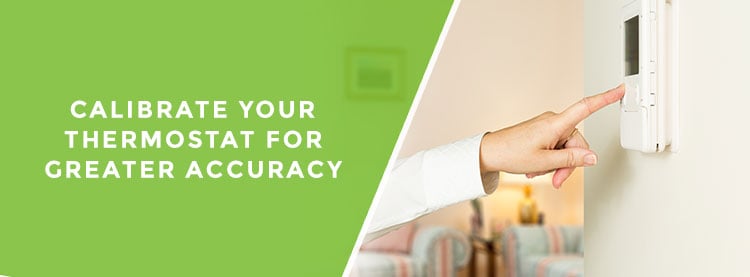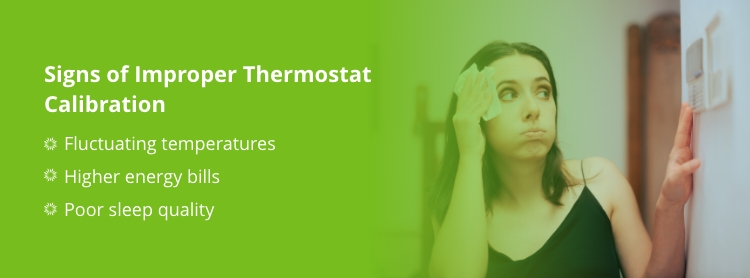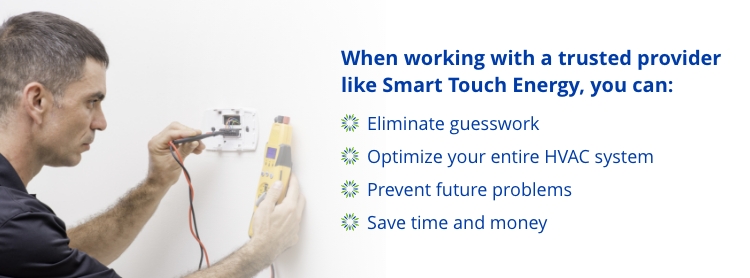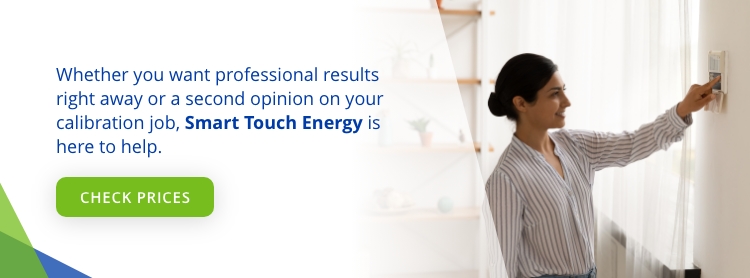
A thermostat is the main point of interface between you and your heating, ventilation, and air conditioning (HVAC) system. When your thermostat is accurate, it’s easier to make fine adjustments that will keep your home comfortable and your utility bills low. Like all components of your home HVAC system, thermostats require periodic repairs and maintenance to keep working their best over the long term. Here’s what you need to know to calibrate your thermostat.
- Thermostat Basics
- Signs of Improper Thermostat Calibration
- How to Check a Thermostat's Calibration
- Cleaning a Thermostat
- Adjusting a Thermostat
- How to Ensure You Calibrate Your Thermostat Correctly
- Benefits of Hiring an HVAC Technician
- Solve Your Thermostat Problems Faster With Smart Touch Energy
Thermostat Basics
There are three main types of thermostats found in homes today — manual thermostats, programmable thermostats, and smart thermostats. The simplest thermostats may only require occasional cleaning to work accurately. More advanced digital units need battery changes, software updates, and other service considerations.
Your first step in ensuring thermostat accuracy should be to consult your owner’s manual to see what periodic maintenance the manufacturer recommends.
Signs of Improper Thermostat Calibration
Your thermostat may lose calibration for numerous reasons, from power loss and dirt buildup to an accidental bump. An improperly calibrated thermostat impacts your HVAC system's functionality and your quality of life. Consider checking your device if you notice signs like:

- Fluctuating temperatures: Some heating systems — such as boiler ones — heat each room separately, and fluctuating temperatures are natural. However, varying temperatures in unzoned homes might indicate a calibration issue. You may also notice erratic cooling cycles.
- Higher energy bills: Thermostats with calibration problems will compensate for incorrect readings, leading to excessively cool or warm temperatures and more adjustments. Even tiny changes matter, raising your energy bill by up to 10%.
- Poor sleep quality: Your bedroom's temperature can impact your sleep. If you often wake up due to hot and stuffy temperatures, it may be time to check your thermostat.
How to Check a Thermostat's Calibration
Checking the calibration of your thermostat is easy and should be done once a year, generally in the fall. To do so, locate your home’s thermostat and tape an accurate thermometer on the wall next to it. Wait 15 minutes and check the temperature reading on both devices.
If your readings are three or fewer degrees apart, you should be good to go. However, if you find that your thermostat is not reading the right temperature, showing a variance greater than three degrees, it may require servicing. This is particularly important to check if you have noticed that your home is either too hot or too cold, which could be a sign of an inaccurate thermostat.
Cleaning a Thermostat
From time to time, a thermostat’s mechanical contacts will require cleaning to maintain accuracy. You can complete this simple maintenance procedure at home:
- Carefully remove the thermostat cover.
- Brush away any dust or dirt you find using a soft cloth or Q-tip.
- If you notice any surface corrosion, remove it using an electrical contact cleaner — you can find one at your local hardware store.
Adjusting a Thermostat
If cleaning your thermostat doesn't fix the problem, several adjustments may do the trick:
- Moving the heat anticipator: If your furnace cycles on and off too frequently, adjust the heat anticipator. Look for a small lever below a scale with an arrow marked “longer.” Moving the level in that direction will increase the length of your HVAC system’s cycling time. Bear in mind, however, that longer cycle times will be less effective at keeping your home at the desired temperature.
- Checking the level: Certain types of thermostats contain a small vial of mercury that must be level to ensure proper temperature control. This orientation can be confirmed with a standard carpenter’s level. If the measurement is off, adjust the placement of the thermostat itself until it’s straight.
- Adjusting the calibration screw: Screw-type thermostats can be adjusted for accuracy using a small screw located on a coil inside the unit. Different products have different calibration techniques, so consult your manual before doing anything.
How to Ensure You Calibrate Your Thermostat Correctly
Improper or delayed calibration can prolong thermostat issues, so it's crucial to get the job done right. However, you may not have a second thermometer or know how to calibrate a digital thermostat. To ensure optimal results, it's best to hire a trained HVAC professional. The better your thermostat works, the more reliable and economical your HVAC system will be.
Smart Touch Energy's air conditioning tune-up service can restore your thermostat's functionality. When you choose us, we'll connect you with your nearest service provider to:
- Measure your system's efficiency and airflow.
- Determine any differences between temperature inputs and outputs.
- Clean your condensate drain and any accessible coils.
- Review your system's refrigerant temperature.
- Clean your air filter or replace it with one of your choosing.
- Lubricate your system.
- Test how well your system starts and stops.
At Smart Touch Energy, we know that air conditioning issues rarely happen at opportune times. Our local partners also provide repair and emergency services, so we'll be there whenever you need us.
Benefits of Hiring an HVAC Technician
Hiring an HVAC expert offers several advantages. When working with a trusted provider like Smart Touch Energy, you can:

- Eliminate guesswork: You want to resolve temperature issues right away, and a DIY calibration may require trial and error. With an HVAC professional, you'll enjoy comfortable temperatures as soon as possible. Our experts have the knowledge and tools to correctly diagnose and fix issues the first time.
- Optimize your entire HVAC system: Smart Touch Energy knows how to calibrate your thermostat and more. We'll address non-thermostat issues and ensure your whole HVAC system is in peak condition.
- Prevent future problems: Our HVAC professionals help you prevent future complications by completing their work precisely, using the proper techniques, and addressing potential problem areas.
- Save time and money: When you work with us, you save on future repair and maintenance costs. You'll also spend less time troubleshooting and more time enjoying cooler, comfier temperatures.
Solve Your Thermostat Problems Faster With Smart Touch Energy
Whether you want professional results right away or a second opinion on your calibration job, Smart Touch Energy is here to help. Our A/C tune-up services will boost your system's performance, your quality of life, and your savings. You can connect with a provider almost anywhere in the Northeast.
Place an order online today by entering your zip code at the top! If you have a question or need more information, we encourage you to contact us or visit our FAQs page.




